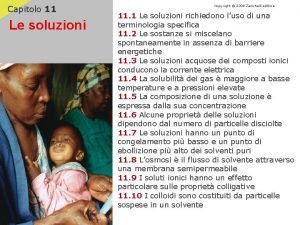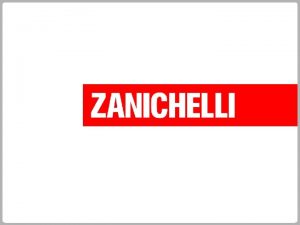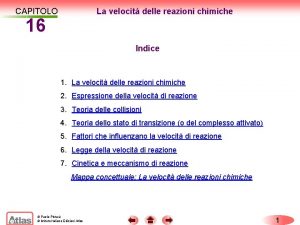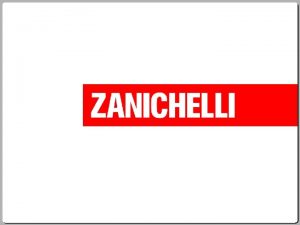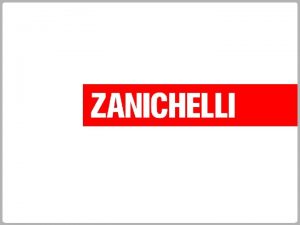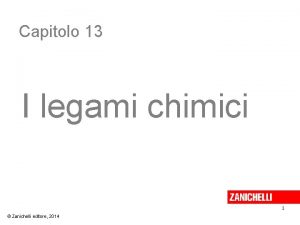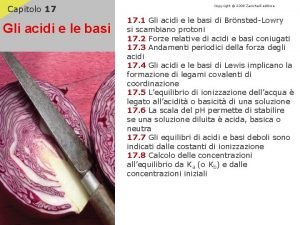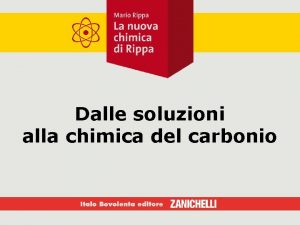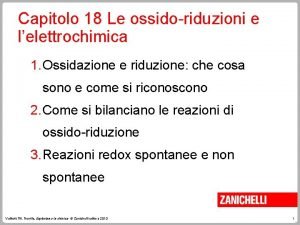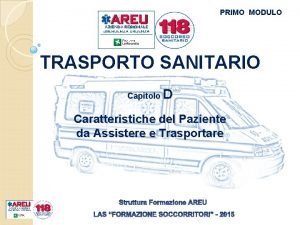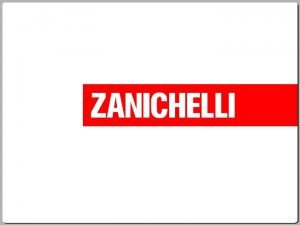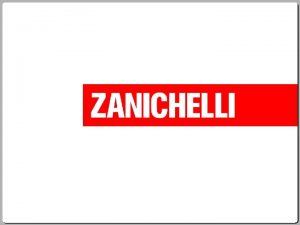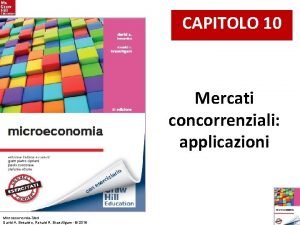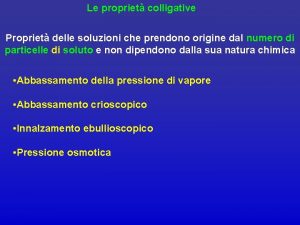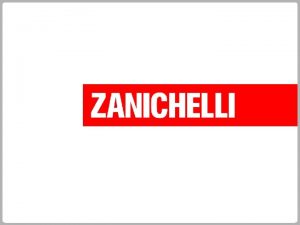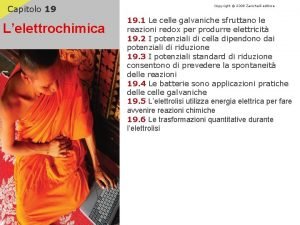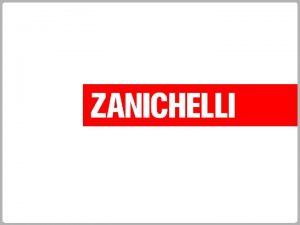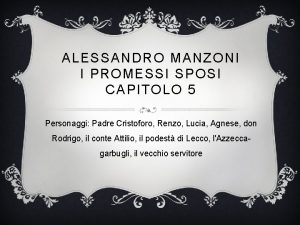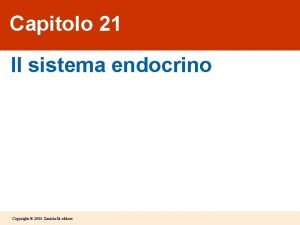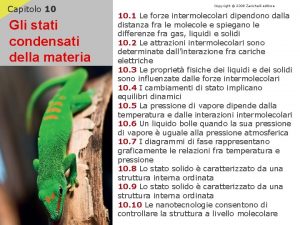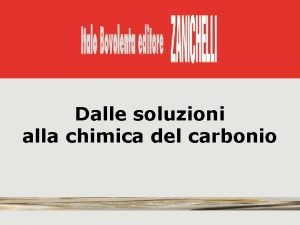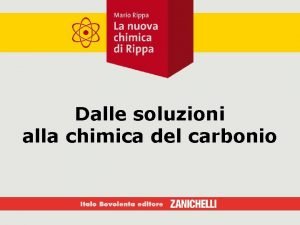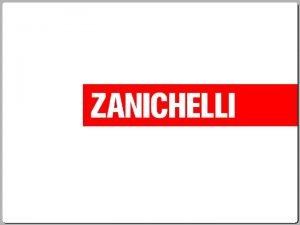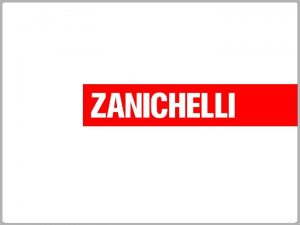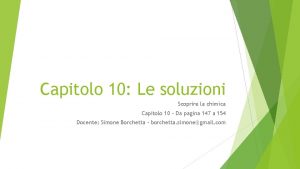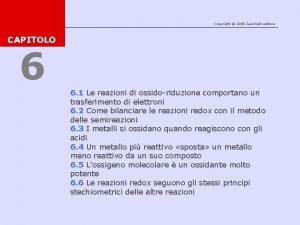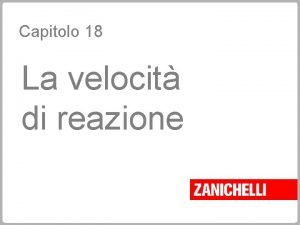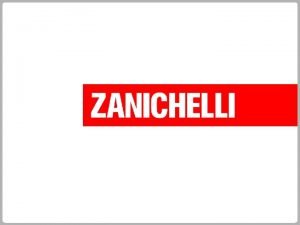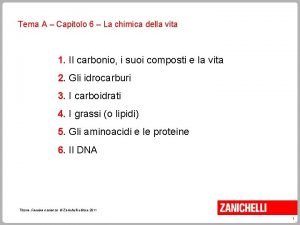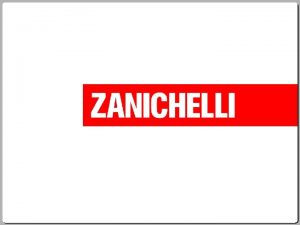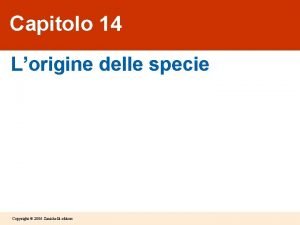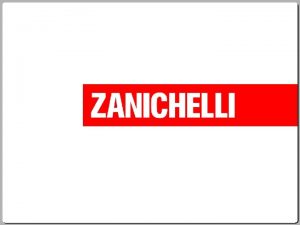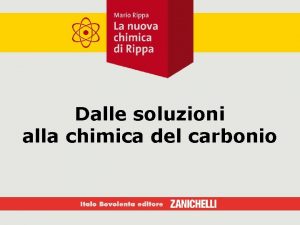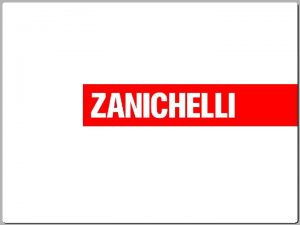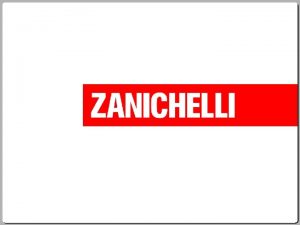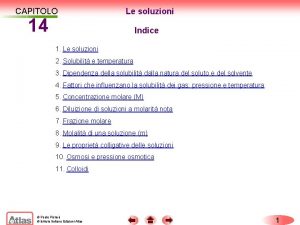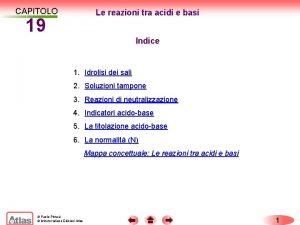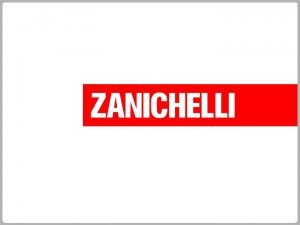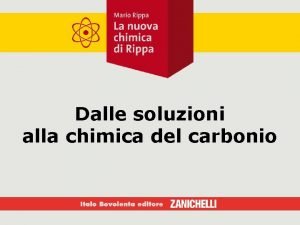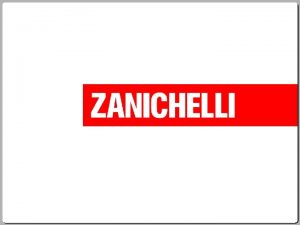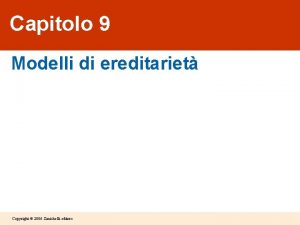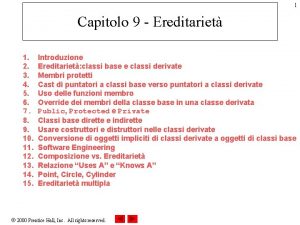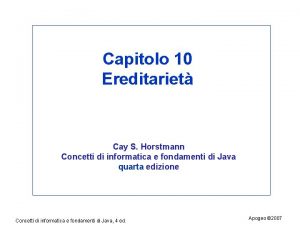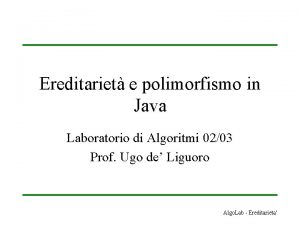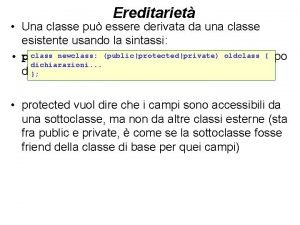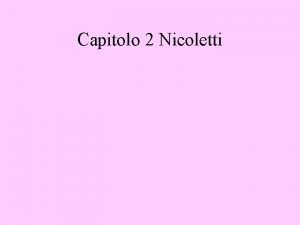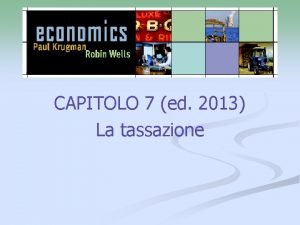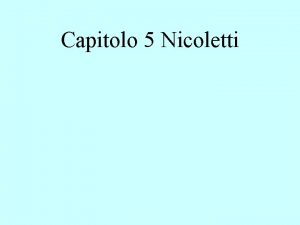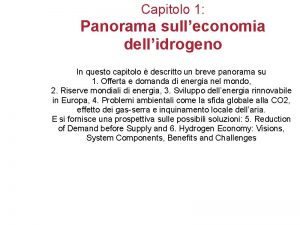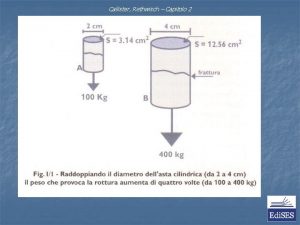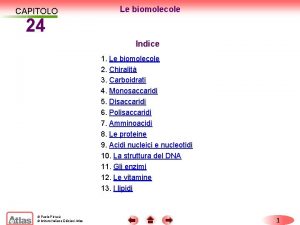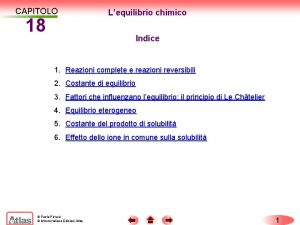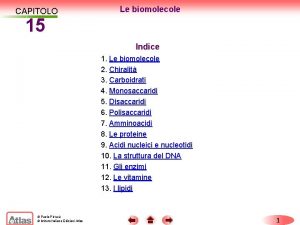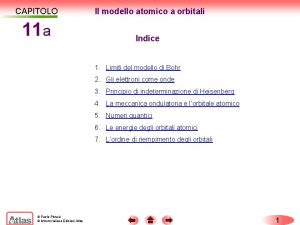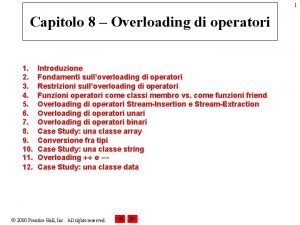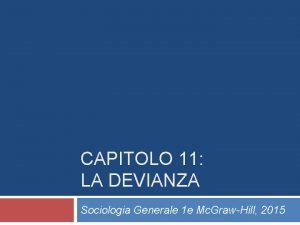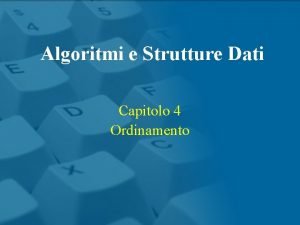1 Capitolo 9 Ereditariet 1 2 3 4













![Point p: [30, 50] Circle c: Center = [120, 89]; Radius = 2. 70 Point p: [30, 50] Circle c: Center = [120, 89]; Radius = 2. 70](https://slidetodoc.com/presentation_image/25e10f1996a3604b9b0edbaed823f2da/image-14.jpg)














![Point constructor: [11, 22] destructor: [11, 22] Outline Point constructor: [72, 29] Circle constructor: Point constructor: [11, 22] destructor: [11, 22] Outline Point constructor: [72, 29] Circle constructor:](https://slidetodoc.com/presentation_image/25e10f1996a3604b9b0edbaed823f2da/image-29.jpg)




















- Slides: 49

1 Capitolo 9 - Ereditarietà 1. 2. 3. 4. 5. 6. 7. 8. 9. 10. 11. 12. 13. 14. 15. Introduzione Ereditarietà: classi base e classi derivate Membri protetti Cast di puntatori a classi base verso puntatori a classi derivate Uso delle funzioni membro Override dei membri della classe base in una classe derivata Public, Protected e Private Classi base dirette e indirette Usare costruttori e distruttori nelle classi derivate Conversione di oggetti impliciti di classi derivate a oggetti di classi base Software Engineering Composizione vs. Ereditarietà Relazione “Uses A” e “Knows A” Point, Circle, Cylinder Ereditarietà multipla 2000 Prentice Hall, Inc. All rights reserved.

2 1. Introduzione Ereditarietà – nuove classi create da precedenti, che assorbono attributi e comportamenti – classi derivate: ereditano dati membro e funzioni membro da una classe base già definita – ereditarietà singola: la classe eredita da una classe base – ereditarietà multipla: la classe eredita da più classe base – tipi di ereditarietà: public: gli oggetti derivati sono accessibili da parte degli oggetti della classe base private: oggetti derivati sono inaccessibili da parte della classe base protected: le classe derivate e i friends possono accedere ai membri protetti della classe base 2000 Prentice Hall, Inc. All rights reserved.

3 Polimorfismo – scrivere programmi generali – manipolare una grande varietà di classi esistenti e non specificate 2000 Prentice Hall, Inc. All rights reserved.

2. Ereditarietà: classi base e classi derivate – spesso un oggetto di una classe derivata (subclass) è anche oggetto di una classe base (superclass) – esempio: un rettangolo è una classe derivata rispetto a un quadrilatero, ed è una classe base rispetto a un quadrato – esempio: 2000 Prentice Hall, Inc. All rights reserved. 4

5 implementazione dell’ereditarietà public class Commission. Worker : public Employee {. . . }; – la classe Commission. Worker eredita dalla classe Employee – le funzioni friend non sono ereditate – i membri private della classe base non sono accessibili da parte della classe derivata 2000 Prentice Hall, Inc. All rights reserved.

6 3. Membri protetti accesso protected – livello di protezione intermedio fra public e private – i membri della classe derivata possono riferirsi ai membri public e protected della classe base semplicemente usando i nomi dei membri – protected rompe l’incapsulamento 2000 Prentice Hall, Inc. All rights reserved.

4. Cast di puntatori a classi base verso puntatori a classi derivate Relazione fra classi base e derivate – gli oggetti di una classe derivata possono essere trattati come oggetti della classe base (il contrario non è vero – oggetti di classe base non sono anche oggetti di classe derivata) Downcasting di puntatore – usare un cast esplicito per convertire un puntatore a classe base in un puntatore a classe derivata – se il puntatore deve essere dereferenziato, il tipo del puntatore deve coincidere con il tipo dell’oggetto a cui il puntatore punta – formato derived. Ptr = static_cast<Derived. Class *> base. Ptr; 2000 Prentice Hall, Inc. All rights reserved. 7

8 esempio seguente: – cast del puntatore a classe base a puntatore a classe derivata – la classe Circle è derivata dalla classe Point – un puntatore di tipo Point è usato per riferirsi a un oggetto Circle, e un puntatore di tipo Circle è usato per riferirsi a un oggetto Point 2000 Prentice Hall, Inc. All rights reserved.

1 2 3 4 5 6 7 8 9 10 11 12 13 14 15 16 17 18 19 20 21 22 23 24 25 26 27 28 29 30 31 32 33 // Fig. 9. 4: point. h // Definition of class Point #ifndef POINT_H #define POINT_H #include <iostream> using std: : ostream; class Point { friend ostream &operator<<( ostream &, const Point & ); public: Point( int = 0, int = 0 ); // default constructor void set. Point( int, int ); // set coordinates int get. X() const { return x; } // get x coordinate int get. Y() const { return y; } // get y coordinate protected: // accessible by derived classes int x, y; // x and y coordinates of the Point }; #endif // Fig. 9. 4: point. cpp // Member functions for class Point #include <iostream> #include "point. h" // Constructor for class Point: : Point( int a, int b ) { set. Point( a, b ); } // Set x and y coordinates of Point void Point: : set. Point( int a, int b ) { 2000 x =Prentice a; Hall, Inc. All rights reserved. Outline 1. Point class definition ------1. Load header 1. 1 Function definitions 9

34 35 36 37 38 39 40 41 42 43 44 45 46 47 48 49 50 51 52 53 54 55 56 57 58 59 60 61 62 63 64 y = b; Outline } // Output Point (with overloaded stream insertion operator) ostream &operator<<( ostream &output, const Point &p ) { output << '[' << p. x << ", " << p. y << ']'; return output; // enables cascaded calls } // Fig. 9. 4: circle. h // Definition of class Circle #ifndef CIRCLE_H #define CIRCLE_H 1. 1 Function definitions ----------1. Circle class definition #include <iostream> using std: : ostream; #include <iomanip> using std: : ios; using std: : setiosflags; using std: : setprecision; Circle eredita pubblicamente dalla classe Point, quindi ha gli stessi dati e funzioni membro (public e protected) di Point #include "point. h" class Circle : public Point { // Circle inherits from Point friend ostream &operator<<( ostream &, const Circle & ); public: 2000 Hall, constructor Inc. All rights reserved. // Prentice default 10

65 Circle( double r = 0. 0, int x = 0, int y = 0 ); Outline 66 67 void set. Radius( double ); // set radius 68 double get. Radius() const; // return radius 69 double area() const; // calculate area 1. Circle definition 70 protected: 71 ----------1. Load header double radius; 72 }; 73 74 #endif 1. 1 Function Definitions 75 // Fig. 9. 4: circle. cpp 76 // Member function definitions for class Circle 77 #include "circle. h" 78 79 // Constructor for Circle calls constructor for Point Circle eredita da Point, ed ha i dati membro di Point (che sono settati chiamamndo il costruttore di Point) 80 // with a member initializer then initializes radius. 81 Circle: : Circle( double r, int a, int b ) 82 : Point( a, b ) // call base-class constructor 83 { set. Radius( r ); } 84 85 // Set radius of Circle 86 void Circle: : set. Radius( double r ) 87 { radius = ( r >= 0 ? r : 0 ); } 88 2000 Prentice Hall, Inc. All rights reserved. 11

89 // Get radius of Circle 90 double Circle: : get. Radius() const { return radius; } 91 92 // Calculate area of Circle 93 double Circle: : area() const 94 { return 3. 14159 * radius; } 95 96 // Output a Circle in the form: 97 // Center = [x, y]; Radius = #. ## 98 ostream &operator<<( ostream &output, const Circle &c ) 99 { 100 output << "Center = " << static_cast< Point >( c ) 101 << "; Radius = " 102 << setiosflags( ios: : fixed | ios: : showpoint ) 103 << setprecision( 2 ) << c. radius; 104 105 return output; // enables cascaded calls 106 } 107 // Fig. 9. 4: fig 09_04. cpp 108 // Casting base-class pointers to derived-class pointers 109 #include <iostream> 110 111 using std: : cout; 112 using std: : endl; 113 114 #include <iomanip> 115 116 #include "point. h" 117 #include "circle. h" 118 119 int main() 120 { Prentice Hall, Inc. All reserved. 121 2000 Point *point. Ptr = rights 0, p( 30, 50 ); Outline 1. 1 Function Definitions -----------Driver 1. Load headers 1. 1 Initialize objects 12

122 Circle *circle. Ptr = 0, c( 2. 7, 120, 89 ); Outline 123 124 cout << "Point p: " << p << " n. Circle c: " << c << 'n'; 125 Point p: [30, 50] 127 // Treat a Circle as a Point (see onlyc: the base =class Circle Center [120, part) 89]; Radius 1. 1 = 2. 70 Initialize point. Ptr = &c; // assign address of Circle to point. Ptr 128 cout << "n. Circle c (via *point. Ptr): " 126 129 << *point. Ptr << 'n'; objects 1. 2 Assign objects Circle c (via *point. Ptr): [120, 89] 130 point. Ptr a un 131 assegna // Treat a Circle as oggetto a Circle (with some casting) 2. Function calls 132 Circle // cast base-class pointer to derived-class pointer 133 circle. Ptr = static_cast< Circle * >( point. Ptr ); 134 cout << "n. Circle c (via *circle. Ptr): n" << *circle. Ptr 135 136 137 assegna il puntatore della << "n. Area of c (via circle. Ptr): " Circle c (via *circle. Ptr): classe derivata (&c) al << circle. Ptr->area() << 'n'; Center = [120, 89]; Radius = 2. 70 puntatore della classe base 138 Area of c (via circle. Ptr): point. Ptr. 22. 90 // DANGEROUS: Treat a Point as a Circle 139 point. Ptr = &p; // assign address of Point to point. Ptr 140 141 // cast base-class pointer to derived-class pointer 142 circle. Ptr = static_cast< Circle * >( point. Ptr ); 143 cout << "n. Point p (via *circle. Ptr): n" << *circle. Ptr 144 145 146 il puntatore della classe base “vede” solo la parte base dell’oggetto a cui Cast point. Ptr in punta Circle * , e lo assegna a circle. Ptr. << "n. Area of object circle. Ptr points to: " circle. Ptr Point p (via *circle. Ptr): << circle. Ptr->area() << endl; return 0; 147 } 2000 Prentice Hall, Inc. All rights reserved. Center = [30, 50]; tratterà c (l’oggetto a cui punta) Radius = 0. 00 come un Circle. Area of object circle. Ptr points to: 0. 00 13
![Point p 30 50 Circle c Center 120 89 Radius 2 70 Point p: [30, 50] Circle c: Center = [120, 89]; Radius = 2. 70](https://slidetodoc.com/presentation_image/25e10f1996a3604b9b0edbaed823f2da/image-14.jpg)
Point p: [30, 50] Circle c: Center = [120, 89]; Radius = 2. 70 Circle c (via *point. Ptr): [120, 89] Circle c (via *circle. Ptr): Center = [120, 89]; Radius = 2. 70 Area of c (via circle. Ptr): 22. 90 Point p (via *circle. Ptr): Center = [30, 50]; Radius = 0. 00 Area of object circle. Ptr points to: 0. 00 2000 Prentice Hall, Inc. All rights reserved. Outline Program Output 14

15 5. Uso delle funzioni membro Funzioni membro di classi derivate – non possono accedere direttamente i membri private delle loro classi base (si mantiene l’incapsulamento) – mascondere i membri private è di grande aiuto nel testing, debugging e modifica di un sistema 2000 Prentice Hall, Inc. All rights reserved.

6. Override dei membri della classe base in una classe derivata Per realizzare l’override di una funzione membro di una classe base – nella classe derivata, fornire una nuova versione della funzione con la stessa signature – quando la funzione è invocata per nome nella classe derivata, la versione derivata è chiamata – l’operatore di scope resolution può essere usato per accedere alla versione della classe base, partendo dalla classe derivata 2000 Prentice Hall, Inc. All rights reserved. 16

1 2 3 4 5 6 7 8 9 10 11 12 13 14 15 16 17 18 19 20 21 22 23 24 25 26 27 28 // Fig. 9. 5: employ. h // Definition of class Employee #ifndef EMPLOY_H #define EMPLOY_H 29 30 31 32 // the first and last names into the object. Employee: : Employee( const char *first, const char *last ) { 2000 Prentice Hall, rights reserved. first. Name = Inc. new All char[ strlen( first ) + 1 ]; class Employee { public: Employee( const char void print() const; ~Employee(); private: char *first. Name; char *last. Name; }; *, const char * ); // constructor // output first and last name // destructor // dynamically allocated string #endif // Fig. 9. 5: employ. cpp // Member function definitions for class Employee #include <iostream> using std: : cout; #include <cstring> #include <cassert> #include "employ. h" // Constructor dynamically allocates space for the // first and last name and uses strcpy to copy Outline 1. Employee class definition -----------1. Load header 1. 1 Function definitions 17

33 34 35 36 37 38 39 40 41 42 43 44 45 46 47 48 49 50 51 assert( first. Name != 0 ); // terminate if not allocated strcpy( first. Name, first ); last. Name = new char[ strlen( last ) + 1 ]; assert( last. Name != 0 ); // terminate if not allocated strcpy( last. Name, last ); Outline 1. 1 Function definitions } // Output employee name void Employee: : print() const { cout << first. Name << ' ' << last. Name; } // Destructor deallocates dynamically allocated memory Employee: : ~Employee() { delete [] first. Name; // reclaim dynamic memory delete [] last. Name; // reclaim dynamic memory } // Fig. 9. 5: hourly. h 52 // Definition of class Hourly. Worker 53 #ifndef HOURLY_H ----------1. Hourly. Worker class definition Hourly. Worker eredita da Employee. 54 #define HOURLY_H 55 56 #include "employ. h" 57 58 class Hourly. Worker : public Employee { 59 public: 60 Hourly. Worker( const char*, double, double ); 61 double get. Pay() const; 62 18 // calculate and return salary void print() const; // overridden base-class print 2000 Prentice Hall, Inc. All rights reserved. 63 private: Hourly. Worker override la funzione print

64 65 66 67 68 69 70 71 72 73 74 75 76 77 78 79 80 81 82 83 84 85 86 87 88 89 90 91 92 93 94 95 double wage; double hours; // wage per hour // hours worked for week }; #endif // Fig. 9. 5: hourly. cpp // Member function definitions for class Hourly. Worker #include <iostream> using std: : cout; using std: : endl; #include <iomanip> using std: : ios; using std: : setiosflags; using std: : setprecision; #include "hourly. h" // Constructor for class Hourly. Worker: : Hourly. Worker( const char *first, const char *last, double init. Hours, double init. Wage ) : Employee( first, last ) // call base-class constructor { hours = init. Hours; // should validate wage = init. Wage; // should validate } // Get the Hourly. Worker's pay 2000 Prentice Hall, Inc. All rights reserved. double Hourly. Worker: : get. Pay() const { return wage * hours; } Outline 1. Load header 1. 1 Function definitions 19

96 97 // Print the Hourly. Worker's name and pay Outline 98 void Hourly. Worker: : print() const 99 { 100 cout << "Hourly. Worker: : print() is executingnn"; 101 Employee: : print(); // call base-class print function 102 103 1. 1 Function Definitions cout << " is an hourly worker with pay of $" 104 << setiosflags( ios: : fixed | ios: : showpoint ) 105 << setprecision( 2 ) << get. Pay() << endl; 106 } 107 // Fig. 9. 5: fig 09_05. cpp 108 // Overriding a base-class member function in a 109 // derived class. 110 #include "hourly. h" 111 112 int main() ----------1. Load header 1. 1 Initialize la funzione print object è sovracaricata in 2. Function call Hourly. Worker. Comunque, la nuova funzione può ancora chiamare la print originale usando : : 113 { 114 Hourly. Worker h( "Bob", "Smith", 40. 0, 10. 00 ); 115 h. print(); 116 return 0; 117 } Hourly. Worker: : print() is executing Bob Smith is an. Hall, hourly with pay of $400. 00 2000 Prentice Inc. Allworker rights reserved. Program Output 20

21 7. Public, Protected e Private 2000 Prentice Hall, Inc. All rights reserved.

22 8. Classi base dirette e indirette Classi base dirette – esplicitamente elencate nell’header, dopo (: ) class Hourly. Worker : public Employee è classe base diretta di Hourly. Worker Classi base indirette – non elencate nell’header della classe (due o più livelli enella gerarchia delle classi) class Minute. Worker : public Hourly. Worker Employee è classe base indiretta di Minute. Worker 2000 Prentice Hall, Inc. All rights reserved.

9. 9 Using Constructors and Destructors in Derived Classes • Base class initializer – Uses member-initializer syntax – Can be provided in the derived class constructor to call the base-class constructor explicitly • Otherwise base class’s default constructor called implicitly – Base-class constructors and base-class assignment operators are not inherited by derived classes • Derived-class constructors and assignment operators, however, can call base-class constructors and assignment operators 2000 Prentice Hall, Inc. All rights reserved. 23

9. Usare costruttori e distruttori nelle classi derivate Un costruttore di classe derivata – chiama il costruttore per la sua classe base per inizializzare i membri della classe base – se è omesso, il costruttore di default chiama il costruttore della classe base I distruttori sono chiamati in ordine inverso rispetto ai costruttori – così un distruttore di classe derivata è chiamato prima del distruttore della relativa classe base 2000 Prentice Hall, Inc. All rights reserved. 24

1 2 3 4 5 6 7 8 9 10 11 12 13 14 15 16 17 18 19 20 21 22 23 24 25 26 27 28 29 30 31 32 // Fig. 9. 7: point 2. h // Definition of class Point #ifndef POINT 2_H #define POINT 2_H class Point { public: Point( int = 0, int = 0 ); // default constructor ~Point(); // destructor protected: // accessible by derived classes int x, y; // x and y coordinates of Point }; #endif // Fig. 9. 7: point 2. cpp // Member function definitions for class Point #include <iostream> using std: : cout; using std: : endl; #include "point 2. h" // Constructor for class Point: : Point( int a, int b ) { x = a; y = b; cout << "Point constructor: " << '[' << x << ", " << y << ']' << endl; 2000 Prentice Hall, Inc. All rights reserved. } Outline 1. Point definition --------1. Load header 1. 1 Function definitions 25

33 Outline 34 // Destructor for class Point 35 Point: : ~Point() 36 { 37 cout << "Point 38 destructor: " << '[' << x << ", " << y << ']' << endl; 1. 1 Function definitions 39 } -----------1. Load header 40 // Fig. 9. 7: circle 2. h 41 // Definition of class Circle 42 #ifndef CIRCLE 2_H 1. 1 Circle Definition 43 #define CIRCLE 2_H 44 45 #include "point 2. h" Circle eredita da Point. 46 47 class Circle : public Point { 48 public: 49 // default constructor 50 Circle( double r = 0. 0, int x = 0, int y = 0 ); 51 52 ~Circle(); 53 private: 54 double radius; 55 }; 56 57 #endif 2000 Prentice Hall, Inc. All rights reserved. 26

58 // Fig. 9. 7: circle 2. cpp 59 // Member function definitions for class Circle Outline 27 60 #include <iostream> 61 1. Load header 62 using std: : cout; 63 using std: : endl; 1. 1 Function Definitions 64 65 #include "circle 2. h" 66 67 // Constructor for Circle calls constructor for Point 68 Circle: : Circle( double r, int a, int b ) 69 : Point( a, b ) // call base-class constructor 70 { 71 radius = r; 72 cout << "Circle constructor: radius is " 73 // should validate il costruttore per Circle chiama il costruttore per Point. << radius << " [" << x << ", " << y << ']' << endl; 74 } 75 76 // Destructor for class Circle 77 Circle: : ~Circle() 78 { 79 80 cout << "Circle destructor: radius is " << radius << " [" << x << ", " << y << ']' << endl; 81 } 2000 Prentice Hall, Inc. All rights reserved. il distruttore per Circle chiama il distruttore per Point, alla fine.

82 // Fig. 9. 7: fig 09_07. cpp Outline 83 // Demonstrate when base-class and derived-class 84 // constructors and destructors are called. 85 #include <iostream> 1. Load headers 86 87 using std: : cout; 1. 1 Initialize objects 88 using std: : endl; 89 90 #include "point 2. h" 2. Objects enter and oggetto creato dentro un blocco; è distrutto leave scope quando si lascia lo scope 91 #include "circle 2. h" 92 93 int main() 94 { 95 // Show constructor and destructor calls for Point 96 { 97 98 Point p( 11, 22 ); Point } 99 ricorda che il costruttore per constructor: 22] Point[11, è chiamato per oggetti Circle prima destructor: [11, 22] del costruttore per Circle Point constructor: [72, 29] Circle constructor: radius is 4. 5 [72, 29] 100 cout << endl; 101 Circle circle 1( 4. 5, 72, 29 ); 102 cout << endl; 103 Circle circle 2( 10, 5, 5 ); Pointdistruttore constructor: [5, 5] per Point Circle destructor: radius is 10 [5, 5] Circle constructor: is 10 [5, 5] chiamato dopo il radius distruttore Point destructor: [5, 5] 104 cout << endl; Circle destructor: radius is 4. 5 [72, 29] 105 return 0; Point [72, 29] 106 } 2000 Prentice Hall, Inc. All rights reserved. per Circle destructor: 28
![Point constructor 11 22 destructor 11 22 Outline Point constructor 72 29 Circle constructor Point constructor: [11, 22] destructor: [11, 22] Outline Point constructor: [72, 29] Circle constructor:](https://slidetodoc.com/presentation_image/25e10f1996a3604b9b0edbaed823f2da/image-29.jpg)
Point constructor: [11, 22] destructor: [11, 22] Outline Point constructor: [72, 29] Circle constructor: radius is 4. 5 [72, 29] Point constructor: [5, 5] Circle constructor: radius is 10 [5, 5] Circle Point destructor: radius is 10 [5, 5] radius is 4. 5 [72, 29] 2000 Prentice Hall, Inc. All rights reserved. Program Output 29

10. Conversione di oggetti impliciti di classi derivate a oggetti di classi base Assegnamento di classi derivate e base – i tipi delle classi base e derivate sono diversi – gli oggetti di classe derivata possono essere trattati come oggetti di classe base • la classe derivata ha membri che corrispondono ai membri della classe base • la classe derivata ha più membri della classe base – gli oggetti di classe base non possono essere trattati come oggetti di classe derivata 2000 Prentice Hall, Inc. All rights reserved. 30

31 Mescolare puntatori a, e oggetti di, classe base e derivata – riferimento a un oggetto di classe base con un puntatore a classe base (consentito) – riferimento a un oggetto di classe derivata con un puntotore a classe derivata (consentito) – riferimento a un oggetto di classe derivata con un puntatore a classe base (possibile syntax error) – riferimento a un oggetto di classe base con un puntatore a classe derivata (syntax error, il puntatore deve prima subire un cast alla classe base) 2000 Prentice Hall, Inc. All rights reserved.

32 11. Software Engineering Le classi sono usate per – “tirare fuori” attributi comuni e comportamenti da mettere nelle classi base – usare l’ereditarietà per crare classi erivate Modifiche a una classe base – le classi derivate non cambiano finchè l’interfaccia public e protected è la stessa – le classi erivate devono essere ricompilate 2000 Prentice Hall, Inc. All rights reserved.

33 12. Composizione vs. Ereditarietà Relazione “IS A” – Ereditarietà (in cui una classe è derivata da un’altra classe) Relazione “HAS A” – Composizione (in cui una classe contiene altre classi come membri) 2000 Prentice Hall, Inc. All rights reserved.

34 13. Relazioni “Uses A” e “Knows A” “Uses a” – un oggetto attiva una chiamata di funzione a una funzione membro di una altro oggetto “Knows a” – un oggetto è a conoscenza di un altro (contiene un puntatore o manipola l’oggetto) 2000 Prentice Hall, Inc. All rights reserved.

35 14, Point, Circle, Cylinder Gerarchia point, circle, cylinder – Point è una classe base – Circle è derivata da Point – Cylinder è derivata da Circle 2000 Prentice Hall, Inc. All rights reserved.

1 2 3 4 5 6 7 8 9 10 11 12 13 14 15 16 17 18 19 20 21 22 23 24 25 26 27 28 29 30 31 32 // Fig. 9. 8: point 2. h // Definition of class Point #ifndef POINT 2_H #define POINT 2_H Outline 1. Point definition #include <iostream> using std: : ostream; 1. 1 Function definitions class Point { friend ostream &operator<<( ostream &, const Point & ); public: Point( int = 0, int = 0 ); // default constructor void set. Point( int, int ); // set coordinates int get. X() const { return x; } // get x coordinate int get. Y() const { return y; } // get y coordinate protected: // accessible to derived classes Point data members are int x, y; // coordinates of the point }; protected to be made #endif // Fig. 9. 8: point 2. cpp // Member functions for class Point #include "point 2. h" // Constructor for class Point: : Point( int a, int b ) { set. Point( a, b ); } // Set the x and y coordinates void Point: : set. Point( int a, int b ) { 2000 x =Prentice a; Hall, Inc. All rights reserved. accessible by Circle. 36

33 y = b; Outline 34 } 35 36 // Output the Point 37 ostream &operator<<( ostream &output, const Point &p ) 38 { 39 output << '[' << p. x << ", " << p. y << ']'; 40 41 return output; // enables cascading 42 } 2000 Prentice Hall, Inc. All rights reserved. 1. 1 Function definitions 37

1 2 3 4 5 6 7 8 9 10 11 12 13 14 15 16 17 18 19 20 21 22 23 24 25 // Fig. 9. 9: circle 2. h // Definition of class Circle #ifndef CIRCLE 2_H #define CIRCLE 2_H #include <iostream> using std: : ostream; #include "point 2. h" class Circle : public Point { friend ostream &operator<<( ostream &, const Circle & ); public: // default constructor Circle( double r = 0. 0, int x = 0, int y = 0 ); void set. Radius( double ); // set radius double get. Radius() const; // return radius double area() const; // calculate area protected: // accessible to derived classes double radius; // radius of the Circle }; #endif // Fig. 9. 9: circle 2. cpp 26 // Member function definitions for class Circle 27 #include <iomanip> 28 29 using std: : ios; 30 using std: : setiosflags; 31 using std: : setprecision; 32 2000 Prentice Hall, Inc. All rights reserved. 33 #include "circle 2. h" Outline 1. circle definition 1. 1 Function definitions Circle data members are protected to be made accessible by Cylinder. 38

34 35 // Constructor for Circle calls constructor for Point Outline 36 // with a member initializer and initializes radius 37 Circle: : Circle( double r, int a, int b ) 38 : Point( a, b ) // call base-class constructor 39 { set. Radius( r ); } 40 41 // Set radius 42 void Circle: : set. Radius( double r ) 43 { radius = ( r >= 0 ? r : 0 ); } 44 45 // Get radius 46 double Circle: : get. Radius() const { return radius; } 47 48 // Calculate area of Circle 49 double Circle: : area() const 50 { return 3. 14159 * radius; } 51 52 // Output a circle in the form: 53 // Center = [x, y]; Radius = #. ## 54 ostream &operator<<( ostream &output, const Circle &c ) 55 { 56 output << "Center = " << static_cast< Point > ( c ) 57 << "; Radius = " 58 << setiosflags( ios: : fixed | ios: : showpoint ) 59 << setprecision( 2 ) << c. radius; 60 61 return output; // enables cascaded calls 62 } 2000 Prentice Hall, Inc. All rights reserved. 1. 1 Function definitions 39

1 // Fig. 9. 10: cylindr 2. h 2 // Definition of class Cylinder 3 #ifndef CYLINDR 2_H 4 #define CYLINDR 2_H Outline 1. Cylinder definition 5 6 #include <iostream> 7 8 using std: : ostream; 9 10 #include "circle 2. h" 11 12 class Cylinder : public Circle { 13 friend ostream &operator<<( ostream &, const Cylinder & ); 14 15 public: 16 // default constructor 17 Cylinder( double h = 0. 0, double r = 0. 0, 18 int x = 0, int y = 0 ); 19 20 void set. Height( double ); // set height 21 double get. Height() const; // return height 22 double area() const; // calculate and return area 23 double volume() const; // calculate and return volume 24 25 protected: 26 double height; 27 }; 28 2000 Prentice Hall, Inc. All rights reserved. 29 #endif 40 // height of the Cylinder

30 31 32 33 34 35 36 37 38 39 40 41 42 43 44 45 46 47 48 49 50 51 52 53 54 55 56 57 58 59 60 // Fig. 9. 10: cylindr 2. cpp // Member and friend function definitions // for class Cylinder. #include "cylindr 2. h" // Cylinder constructor calls Circle constructor Cylinder: : Cylinder( double h, double r, int x, int y ) : Circle( r, x, y ) // call base-class constructor { set. Height( h ); } Outline 1. 1 Function definitions // Set height of Cylinder void Cylinder: : set. Height( double h ) { height = ( h >= 0 ? h : 0 ); } // Get height of Cylinder double Cylinder: : get. Height() const { return height; } // Calculate area of Cylinder (i. e. , surface area) double Cylinder: : area() const { return 2 * Circle: : area() + 2 * 3. 14159 * radius * height; } // Calculate volume of Cylinder double Cylinder: : volume() const { return Circle: : area() * height; } // Output Cylinder dimensions ostream &operator<<( ostream &output, const Cylinder &c ) { 2000 Prentice Hall, Inc. All rights reserved. Circle: : area() is overidden. 41

61 output << static_cast< Circle >( c ) 62 << "; Height = " << c. height; Outline 63 64 return output; // enables cascaded calls 65 } 66 67 68 69 70 71 72 73 74 75 76 77 78 79 80 81 82 83 84 85 86 87 88 89 90 91 // Fig. 9. 10: fig 09_10. cpp // Driver for class Cylinder #include <iostream> using std: : cout; using std: : endl; #include "point 2. h" #include "circle 2. h" #include "cylindr 2. h" int main() { // create Cylinder object Cylinder cyl( 5. 7, 2. 5, 12, 23 ); // use get functions to display the Cylinder cout << "X coordinate is " << cyl. get. X() << "n. Y coordinate is " << cyl. get. Y() << "n. Radius is " << cyl. get. Radius() << "n. Height is " << cyl. get. Height() << "nn"; // use set functions to change the Cylinder's attributes cyl. set. Height( 10 ); cyl. set. Radius( 4. 25 ); 2000 Prentice Hall, Inc. 2, All 2 rights cyl. set. Point( ); reserved. 1. 1 Function definitions -----------1. Load headers 1. 1 Initialize object 2. Function calls 2. 1 Change attributes 3. Output data X coordinate is 12 Y coordinate is 23 Radius is 2. 5 Height is 5. 7 42

92 93 94 95 96 97 98 99 100 101 102 103 104 105 106 107 108 109 } cout << "The new location, radius, and height of cyl are: n" << cyl << 'n'; cout << "The area of cyl is: n" << cyl. area() << 'n'; Outline The new location, radius, and height of cyl are: Center = [2, 2]; Radius = 4. 25; Height = 10. 00 The area of cyl is: // display the Cylinder as a Point 3. Output data Point &p. Ref = cyl; // p. Ref "thinks"380. 53 it is a Point cout << "n. Cylinder printed as a Point is: " << p. Ref << "nn"; Cylinder printed as a Point is: [2, 2] // display the Cylinder as a Circle &circle. Ref = cyl; // circle. Ref thinks it is a Circle pref "thinks" cyl is a Point, cout << "Cylinder printed as a Circle is: n" << circle. Ref prints as one. << "n. Area: " << circle. Ref. area() << endl; Cylinder printed as a Circle is: return 0; Center = [2, 2]; Radius = 4. 25 Area: 56. 74 X coordinate is 12 Y coordinate is 23 Radius is 2. 5 Height is 5. 7 The new location, radius, and height of cyl are: Center = [2, 2]; Radius = 4. 25; Height = 10. 00 The area of cyl is: 380. 53 Cylinder printed as a Point is: [2, 2] Cylinder printed as a Circle is: Center = [2, 2]; Radius = 4. 25 Area: 56. 74 2000 Prentice Hall, Inc. All rights reserved. so it circleref "thinks" cyl is a Circle, so it prints as. Program one. Output 43

44 15. Ereditarietà multipla – classi derivate ereditano da più classi base – incoraggia il riuso del software, ma crea ambiguità 2000 Prentice Hall, Inc. All rights reserved.

1 // Fig. 9. 11: base 1. h 2 // Definition of class Base 1 3 #ifndef BASE 1_H 4 #define BASE 1_H 1. Base 1 definition 5 6 class Base 1 { 7 public: 8 Base 1( int x ) { value = x; } 9 int get. Data() const { return value; } 10 protected: // accessible to derived classes 11 // inherited by derived class int value; 12 }; 13 14 #endif 15 16 17 18 19 20 21 22 23 24 25 26 Outline // Fig. 9. 11: base 2. h // Definition of class Base 2 #ifndef BASE 2_H #define BASE 2_H class Base 2 { public: Base 2( char c ) { letter = c; } char get. Data() const { return letter; } protected: // accessible to derived classes char letter; // inherited by derived class }; 27 2000 Prentice Hall, Inc. All rights reserved. 28 #endif ----------1. Base 2 definition 45

29 // Fig. 9. 11: derived. h Outline 30 // Definition of class Derived which inherits 31 // multiple base classes (Base 1 and Base 2). 32 #ifndef DERIVED_H 1. Derived Definition 33 #define DERIVED_H 34 35 #include <iostream> 36 37 using std: : ostream; 38 39 #include "base 1. h" Derived eredita da Base 1 e Base 2. 40 #include "base 2. h" 41 42 // multiple inheritance 43 class Derived : public Base 1, public Base 2 { 44 friend ostream &operator<<( ostream &, const Derived & ); 45 46 public: 47 Derived( int, char, double ); 48 double get. Real() const; 49 50 private: 51 double real; // derived class's private data 52 }; 53 2000 Prentice Hall, Inc. All rights reserved. 54 #endif 46

55 56 57 58 59 60 61 62 63 64 65 66 67 68 69 70 71 72 73 74 75 76 77 78 79 80 81 82 83 84 85 // Fig. 9. 11: derived. cpp // Member function definitions for class Derived #include "derived. h" // Constructor for Derived calls constructors for // class Base 1 and class Base 2. // Use member initializers to call base-class constructors Derived: : Derived( int i, char c, double f ) : Base 1( i ), Base 2( c ), real ( f ) { } // Return the value of real double Derived: : get. Real() const { return real; } // Display all the data members of Derived ostream &operator<<( ostream &output, const Derived &d ) { output << " Integer: " << d. value << "n Character: " << d. letter << "n. Real number: " << d. real; return output; // enables cascaded calls } // Fig. 9. 11: fig 09_11. cpp // Driver for multiple inheritance example #include <iostream> using std: : cout; using std: : endl; #include "base 1. h" 2000 Prentice Hall, Inc. All rights reserved. #include "base 2. h" Outline 1. Load header 1. 1 Function Definitions 47

86 #include "derived. h" 48 87 88 int main() 89 { 1. Load header 90 Base 1 b 1( 10 ), *base 1 Ptr = 0; // create Base 1 object 91 Base 2 b 2( 'Z' ), *base 2 Ptr = 0; // create Base 2 object 92 Derived d( 7, 'A', 3. 5 ); // create Derived object 1. 1 Create objects 93 94 // print data members of base class objects 95 cout << "Object b 1 contains integer " << b 1. get. Data() 2. Function calls 96 << "n. Object b 2 contains character " << b 2. get. Data() 97 << "n. Object d contains: n" << d << "nn"; Object b 1 contains 3. Outputinteger data 10 98 Object of b 2 Derived containscan character Z Data members be accessed 99 // print data members of derived class object individually: 100 // scope resolution operator resolves get. Data ambiguity Object d contains: Integer: 7 101 cout << "Data members of Derived can be" Integer: 7 102 << " accessed individually: " Character: A 103 << "n Integer: " << d. Base 1: : get. Data() Real number: 3. 5 104 << "n Character: " << d. Base 2: : get. Data() 105 << "n. Real number: " << d. get. Real() << "nn"; Treat d as a Base 1 object. 106 107 cout << "Derived can be treated as an " 108 << "object of either base class: n"; 109 Derived can be treated as an object of either base class: 110 // treat Derived as a Base 1 object 111 base 1 Ptr = &d; Treat d as a Base 2 object. 112 cout << "base 1 Ptr->get. Data() yields " base 1 Ptr->get. Data() yields 7 113 << base 1 Ptr->get. Data() << 'n'; 114 115 // treat Derived as a Base 2 object Prentice Hall, Inc. All rights reserved. 116 2000 base 2 Ptr = &d; Outline

117 118 cout << "base 2 Ptr->get. Data() yields " base 2 Ptr->get. Data() yields A << base 2 Ptr->get. Data() << endl; Outline 119 120 return 0; 3. Output data 121 } Object b 1 contains integer 10 Object b 2 contains character Z Object d contains: Integer: 7 Character: A Real number: 3. 5 Data members Integer: Character: Real number: of Derived can be accessed individually: 7 A 3. 5 Derived can be treated as an object of either base class: base 1 Ptr->get. Data() yields 7 base 2 Ptr->get. Data() yields A 2000 Prentice Hall, Inc. All rights reserved. Program Output 49
 Le soluzioni zanichelli
Le soluzioni zanichelli Capitolo a1 dal carbonio agli idrocarburi
Capitolo a1 dal carbonio agli idrocarburi Capitolo 16 le reazioni chimiche soluzioni
Capitolo 16 le reazioni chimiche soluzioni Chimica più soluzioni capitolo 8
Chimica più soluzioni capitolo 8 Chimica più soluzioni capitolo 18
Chimica più soluzioni capitolo 18 Capitolo 13 chimica zanichelli
Capitolo 13 chimica zanichelli Dalla materia all'atomo soluzioni capitolo 3
Dalla materia all'atomo soluzioni capitolo 3 Acidi e basi si scambiano protoni zanichelli
Acidi e basi si scambiano protoni zanichelli Soluzioni chimica capitolo 14
Soluzioni chimica capitolo 14 Ossidazione e riduzione
Ossidazione e riduzione Test primo modulo capitolo d
Test primo modulo capitolo d Chimica più soluzioni capitolo 11
Chimica più soluzioni capitolo 11 Numero quantico magnetico
Numero quantico magnetico Capitolo 10 scenario 10
Capitolo 10 scenario 10 Osmosi e pressione osmotica
Osmosi e pressione osmotica Chimica zanichelli soluzioni capitolo 16
Chimica zanichelli soluzioni capitolo 16 Dalle soluzioni all'elettrochimica soluzioni capitolo 19
Dalle soluzioni all'elettrochimica soluzioni capitolo 19 Soluzioni il racconto della chimica
Soluzioni il racconto della chimica Geometria ammoniaca
Geometria ammoniaca Il podestà promessi sposi
Il podestà promessi sposi Sistema endocrino zanichelli
Sistema endocrino zanichelli Stati condensati della materia
Stati condensati della materia Soluzioni chimica più capitolo 8
Soluzioni chimica più capitolo 8 Chimica più soluzioni capitolo 12
Chimica più soluzioni capitolo 12 Chimica più dalla mole alla nomenclatura soluzioni
Chimica più dalla mole alla nomenclatura soluzioni Chimica più soluzioni capitolo 20
Chimica più soluzioni capitolo 20 Chimica molecole in movimento soluzioni capitolo 14
Chimica molecole in movimento soluzioni capitolo 14 Chimica piu capitolo 10 soluzioni
Chimica piu capitolo 10 soluzioni Zanichelli chimica soluzioni capitolo 6
Zanichelli chimica soluzioni capitolo 6 Soluzioni chimica zanichelli capitolo 18
Soluzioni chimica zanichelli capitolo 18 Le reazioni chimiche zanichelli capitolo 14
Le reazioni chimiche zanichelli capitolo 14 Soluzioni chimica zanichelli capitolo 6
Soluzioni chimica zanichelli capitolo 6 Soluzioni chimica piu capitolo 22
Soluzioni chimica piu capitolo 22 Capitolo 14 chimica zanichelli
Capitolo 14 chimica zanichelli Posca fiorani chimica più soluzioni
Posca fiorani chimica più soluzioni La nuova chimica di rippa soluzioni
La nuova chimica di rippa soluzioni Reazioni reversibili e irreversibili
Reazioni reversibili e irreversibili Chimica più verde soluzioni
Chimica più verde soluzioni Soluzioni capitolo 14
Soluzioni capitolo 14 Il grande gatsby capitolo 3
Il grande gatsby capitolo 3 Mappa concettuale acidi e basi
Mappa concettuale acidi e basi Soluzioni chimica capitolo 17
Soluzioni chimica capitolo 17 Soluzioni il racconto delle scienze naturali
Soluzioni il racconto delle scienze naturali La chimica di rippa soluzioni
La chimica di rippa soluzioni Amoris laetitia capitolo 7
Amoris laetitia capitolo 7 Chimica più soluzioni capitolo 5
Chimica più soluzioni capitolo 5
